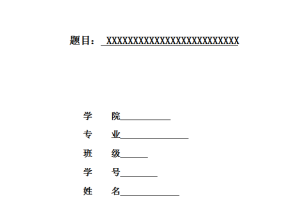摘 要
《猜火车》是苏格兰知名作家欧文·威尔士的一部著名小说。小说生动地描写了二十世纪七十年代生活在苏格兰爱丁堡利兹地区四个年轻人在成长过程中遇到的种种困惑。
七十年代时,英国经济开始走下坡路,随之而来的是失业率上升, 社会秩序混乱。在这种背景下,人们固有的信仰被摧毁,青年一代滋生了迷茫和彷徨的情绪,青年亚文化(对社会主流文化的一种抵抗,其具有边缘性、颠覆性、反社会及反传统等特点)随之应运而生。置身于青年亚文化圈中的青年,对自己的身份认同感到困惑。他们置身于主流文化之外, 不为主流社会接纳和承认, 而其自身的文化特征也使得身份认同成为一个难题。由此培植了一些亚文化群体。
本文在青年亚文化观的基础上,试图挖掘《猜火车》中主人公们所表现出来的种种青年亚文化的倾向及特点,并对之进行深入分析和品评,以期引起更多的人关注青年群体,关注青年的健康成长。
全文共有五章。第一章论文简述作者的写作及生活背景,介绍了这部小说的主要内容和主要人物。第二章是文献综述。介绍国内外对该小说的研究现状及相关批评理论。第三章论述青年亚文化观。在第四章中,论文从青年亚文化角度对该小说进行了全面分析。第五章是结论部分。
关键词: 文化 青年亚文化 主流文化 猜火车 社会身份
Abstract
Trainspotting is an extremely popular novel written by the famous British writer, Irving Welsh who is generally referred to as “ the poet laureate of the drug era”. It depicts the decadent life of four youths who lived in Edinburgh and the various confusions they came across during their growth. It provides a relatively real portrait of the young people living in Scotland and gives an accurate account of identity dilemma existing among them.
In the 1970s, the economic condition in England began to go from bad to worth, thus the rate of employment went up and the social circumstances, the original belief of British people was destroyed, and the youth were at a loss and thus the youth subculture came into being, which is a culture that is again the mainstream culture, having a lot of characteristics, remarked as against the society and tradition, falling around edge. Being an outsider of this circle, the youth can not be accepted by the society and at the same time be admitted by the circle as well. Besides, the cultural feature of themselves also has its own problems. The relevant expressions are confused about the future, the resistance towards the power and the denying towards themselves.
This thesis, from the perspective of youth subculture, attempts to analyze the tendencies and characteristics of youth subculture reflected in the characters in Trainspotting in order to arouse more and more people to show their deep concern over the youth group and the healthy development of them.
The thesis falls into five chapters. Chapter one gives a brief introduction to the author, the novel itself, the writing background and the main characters. Chapter two is literature review, introducing the previous studies both at home and abroad and relevant critical theory. In chapter three, youth subculture is presented and analyzed. Chapter four provides a thorough analysis of the novel from the perspective of youth subculture. Chapter five is the conclusion.
Key words: Culture; Youth subculture; Mainstream culture; Trainspotting; Social identity
Contents:
独创性声明………………………………………………………………………………………..I
摘要……………………………………………………………………………………………….II
Abstract..…………………………………………………………………………….III
Contents…..………………………………………………………………………….V
Chapter One Introduction………………………………………………………………………………….. 1
1.1 Introduction to the Author………………………………………………………………………. 1
1.2 Introduction to the Novel……………………………………………………………………….. 3
1.3 Aim of the Study…………………………………………………………………………………… 6
1.4 Organization of the Thesis………………………………………………………………………. 7
Chapter Two Literature Review……………………………………………………………………….. 8
2.1 Previous Studies…………………………………………………………………………………… 8
2.2 Relevant Theories…………………………………………………………………………………. 9
Chapter Three The Youth Subculture……………………………………………………………….. 14
3.1 Introduction to Youth Subculture……………………………………………………………. 14
3.2 Reasons Causing Youth Subculture…………………………………………………………. 14
3.2.1 Demography…………………………………………………………………………….. 14
3.2.2 Economy………………………………………………………………………………….. 15
3.2.3 Social Reforms………………………………………………………………………….. 16
3.2.4 Education…………………………………………………………………………………. 17
3.2.5 Conscription……………………………………………………………………………… 19
3.2.6 Mass Culture…………………………………………………………………………….. 20
3.2.7 Summary………………………………………………………………………………….. 21
Chapter Four Analysis of Trainspotting in Light of Youth Subculture…………………….. 22
4.1 About Choosing…………………………………………………………………………………. 22
4.2 Rejection…………………………………………………………………………………………… 26
4.3 Addicted to Heroin………………………………………………………………………… 30
4.4 Bodily Functions Control……………………………………………………………….. 38
4.5 Self-centeredness………………………………………………………………………………. 41
4.6 Completely Isolated……………………………………………………………………….. 44
4.7 Youth Music Genres……………………………………………………………………….. 46
4.8 Named “Friendship”………………………………………………………………………. 51
4.9 Rebirth Desire…………………………………………………………………………………… 56
4.10 The Disordered Sexual Relationship……………………………………………………… 59
4.11 Summary………………………………………………………………………………………. 65
Chapter Five Conclusion…………………………………………………………………………………. 66
Bibliography………………………………………………………………………………………………….. 69
Acknowledgments…………………………… …………………………………….. 73





